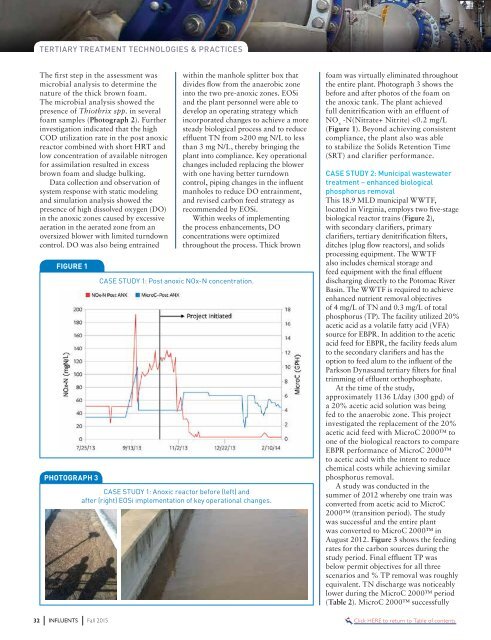lauren@kelman.ca
1YLWYxL
1YLWYxL
You also want an ePaper? Increase the reach of your titles
YUMPU automatically turns print PDFs into web optimized ePapers that Google loves.
TERTIARY TREATMENT TECHNOLOGIES & PRACTICES<br />
The first step in the assessment was<br />
microbial analysis to determine the<br />
nature of the thick brown foam.<br />
The microbial analysis showed the<br />
presence of Thiothrix spp. in several<br />
foam samples (Photograph 2). Further<br />
investigation indi<strong>ca</strong>ted that the high<br />
COD utilization rate in the post anoxic<br />
reactor combined with short HRT and<br />
low concentration of available nitrogen<br />
for assimilation resulted in excess<br />
brown foam and sludge bulking.<br />
Data collection and observation of<br />
system response with static modeling<br />
and simulation analysis showed the<br />
presence of high dissolved oxygen (DO)<br />
in the anoxic zones <strong>ca</strong>used by excessive<br />
aeration in the aerated zone from an<br />
oversized blower with limited turndown<br />
control. DO was also being entrained<br />
FIGURE 1<br />
PHOTOGRAPH 3<br />
32 INFLUENTS Fall 2015<br />
within the manhole splitter box that<br />
divides flow from the anaerobic zone<br />
into the two pre-anoxic zones. EOSi<br />
and the plant personnel were able to<br />
develop an operating strategy which<br />
incorporated changes to achieve a more<br />
steady biologi<strong>ca</strong>l process and to reduce<br />
effluent TN from >200 mg N/L to less<br />
than 3 mg N/L, thereby bringing the<br />
plant into compliance. Key operational<br />
changes included replacing the blower<br />
with one having better turndown<br />
control, piping changes in the influent<br />
manholes to reduce DO entrainment,<br />
and revised <strong>ca</strong>rbon feed strategy as<br />
recommended by EOSi.<br />
Within weeks of implementing<br />
the process enhancements, DO<br />
concentrations were optimized<br />
throughout the process. Thick brown<br />
CASE STUDY 1: Post anoxic NOx-N concentration.<br />
CASE STUDY 1: Anoxic reactor before (left) and<br />
after (right) EOSi implementation of key operational changes.<br />
foam was virtually eliminated throughout<br />
the entire plant. Photograph 3 shows the<br />
before and after photos of the foam on<br />
the anoxic tank. The plant achieved<br />
full denitrifi<strong>ca</strong>tion with an effluent of<br />
NO x<br />
-N(Nitrate+ Nitrite)


